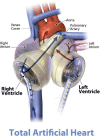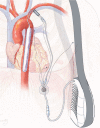How New Support Devices Change Critical Care Delivery
- PMID: 29977466
- PMCID: PMC6027720
- DOI: 10.14797/mdcj-14-2-101
How New Support Devices Change Critical Care Delivery
Abstract
Mechanical support devices are used to support failing cardiac, respiratory, or both systems. Since Gibbon developed the cardiopulmonary bypass in 1953, collaborative efforts by medical centers, bioengineers, industry, and the National Institutes of Health have led to development of mechanical devices to support heart, lung, or both. These devices are used as a temporary or long-term measures for acute collapse of circulatory system and/or respiratory failure. Patients are managed on these support devices as a bridge to recovery, bridge to long term devices, or bridge to transplant. The progress in development of these devices has improved mortality and quality of life in select groups of patients. Care of these patients requires a multidisciplinary team approach, which includes cardiac surgeons, critical care physicians, cardiologists, pulmonologists, nursing staff, and perfusionists. Using a team approach improves outcomes in these patients.
Keywords: critical care management; mechanical circulatory support devices; role of multidisciplinary team.
Conflict of interest statement
Conflict of Interest Disclosure: The authors have completed and submitted the Methodist DeBakey Cardiovascular Journal Conflict of Interest Statement and none were reported.
Figures






Similar articles
-
The Role and Impact of Extracorporeal Membrane Oxygenation in Critical Care.Methodist Debakey Cardiovasc J. 2018 Apr-Jun;14(2):110-119. doi: 10.14797/mdcj-14-2-110. Methodist Debakey Cardiovasc J. 2018. PMID: 29977467 Free PMC article. Review.
-
Mechanical circulatory support for patients with cardiogenic shock.Trends Cardiovasc Med. 2019 Oct;29(7):410-417. doi: 10.1016/j.tcm.2018.11.014. Epub 2018 Dec 5. Trends Cardiovasc Med. 2019. PMID: 30573276 Review.
-
A Review of percutaneous mechanical support devices and strategies.Rev Cardiovasc Med. 2018 Mar 30;19(1):21-26. doi: 10.31083/j.rcm.2018.01.904. Rev Cardiovasc Med. 2018. PMID: 31032599 Review.
-
Acute Mechanical Circulatory Support for Cardiogenic Shock.Methodist Debakey Cardiovasc J. 2020 Jan-Mar;16(1):27-35. doi: 10.14797/mdcj-16-1-27. Methodist Debakey Cardiovasc J. 2020. PMID: 32280415 Free PMC article. Review.
-
Mechanical circulatory support devices in advanced heart failure: 2020 and beyond.Prog Cardiovasc Dis. 2020 Sep-Oct;63(5):630-639. doi: 10.1016/j.pcad.2020.09.003. Epub 2020 Sep 21. Prog Cardiovasc Dis. 2020. PMID: 32971112 Review.
References
-
- The artificial heart program: current status and history. Institute of Medicine (US) Committee to Evaluate the Artificial Heart Program of the National Heart, Lung, and Blood Institute. : Hogness JR, VanAntwerp M, . The artificial heart: prototypes, policies, and patients. Washington, DC: National Academies Press (US); 1991. - PubMed
-
- Thiele H, Jobs A, Ouweneel DM, . et al. Percutaneous short-term active mechanical support devices in cardiogenic shock: a systematic review and collaborative meta-analysis of randomized trials. Eur Heart J. 2017. December 14; 38 47: 3523– 31. - PubMed
-
- Maini B. Letter by Maini regarding article, “percutaneous left-ventricular support with the impella-2.5-assist device in acute cardiogenic shock: results of the impella-EUROSHOCK-registry”. Circ Heart Fail. 2013. July; 6 4: e55. - PubMed
-
- Friedman PA, Munger TM, Torres N, Rihal C.. Percutaneous endocardial and epicardial ablation of hypotensive ventricular tachycardia with percutaneous left ventricular assist in the electrophysiology laboratory. J Cardiovasc Electrophysiol. 2007. January; 18 1: 106– 9. - PubMed
-
- Port SC, Patel S, Schmidt DH.. Effects of intraaortic balloon counterpulsation on myocardial blood flow in patients with severe coronary artery disease. J Am Coll Cardiol. 1984. June; 3 6: 1367– 74. - PubMed
Publication types
MeSH terms
LinkOut - more resources
Full Text Sources
Medical

